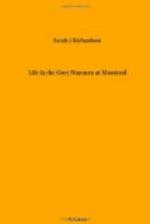This statement was confirmed by Mrs. Pangborn, a sister of the late Mrs Branard, the lady with whom Sarah J. Richardson stopped in St. Albans, and by whom she was employed as a seamstress. Being an inmate of the family at the time, Mrs Pangborn states that she had every opportunity to become acquainted with the girl and learn her true character. The family, she says, were all interested in her, although they knew nothing of her secret, until a few days before she left. She speaks of her as being “quiet and thoughtful, diligent, faithful and anxious to please, but manifesting an eager desire for learning, that she might be able to acquaint herself more perfectly with the Holy Scriptures. She could, at that time, read a little, and her mind was well stored with select passages from the sacred volume, which she seemed to take great delight in repeating. She was able to converse intelligently upon almost any subject, and never seemed at a loss for language to express her thoughts. No one could doubt that nature had given her a mind capable of a high degree of religious and intellectual culture, and that, with the opportunity for improvement, she would become a useful member of society. Of book knowledge she was certainly quite ignorant, but she had evidently studied human nature to some good purpose.” Mrs Pangborn also corroborates many of the statements in her narrative. She often visited the Grey Nunnery, and says that the description given of the building, the Academy, the Orphan’s Home, and young ladies school, are all correct. The young Smalley mentioned in the narrative was well known to her, and also his sister “little Sissy Smalley,” as they used to call her. Inquiries have been made of those acquainted with the route along which the fugitive passed in her hasty flight, and we are told that the description is in general correct; that even the mistakes serve to prove the truthfulness of the narrator, being such as a person would be likely to make when describing from memory scenes and places they had seen but once; whereas, if they were getting up a fiction which they designed to represent as truth, such mistakes would be carefully avoided.
APPENDIX I.
Absurdities of Romanists.
It may perchance be thought by some persons that the foregoing narrative contains many things too absurd and childish for belief. “What rational man,” it may be said, “would ever think of dressing up a figure to represent the devil, for the purpose of frightening young girls into obedience? And those absurd threats! Surely no sane man, and certainly no Christian teacher, would ever stoop to such senseless mummery!”




